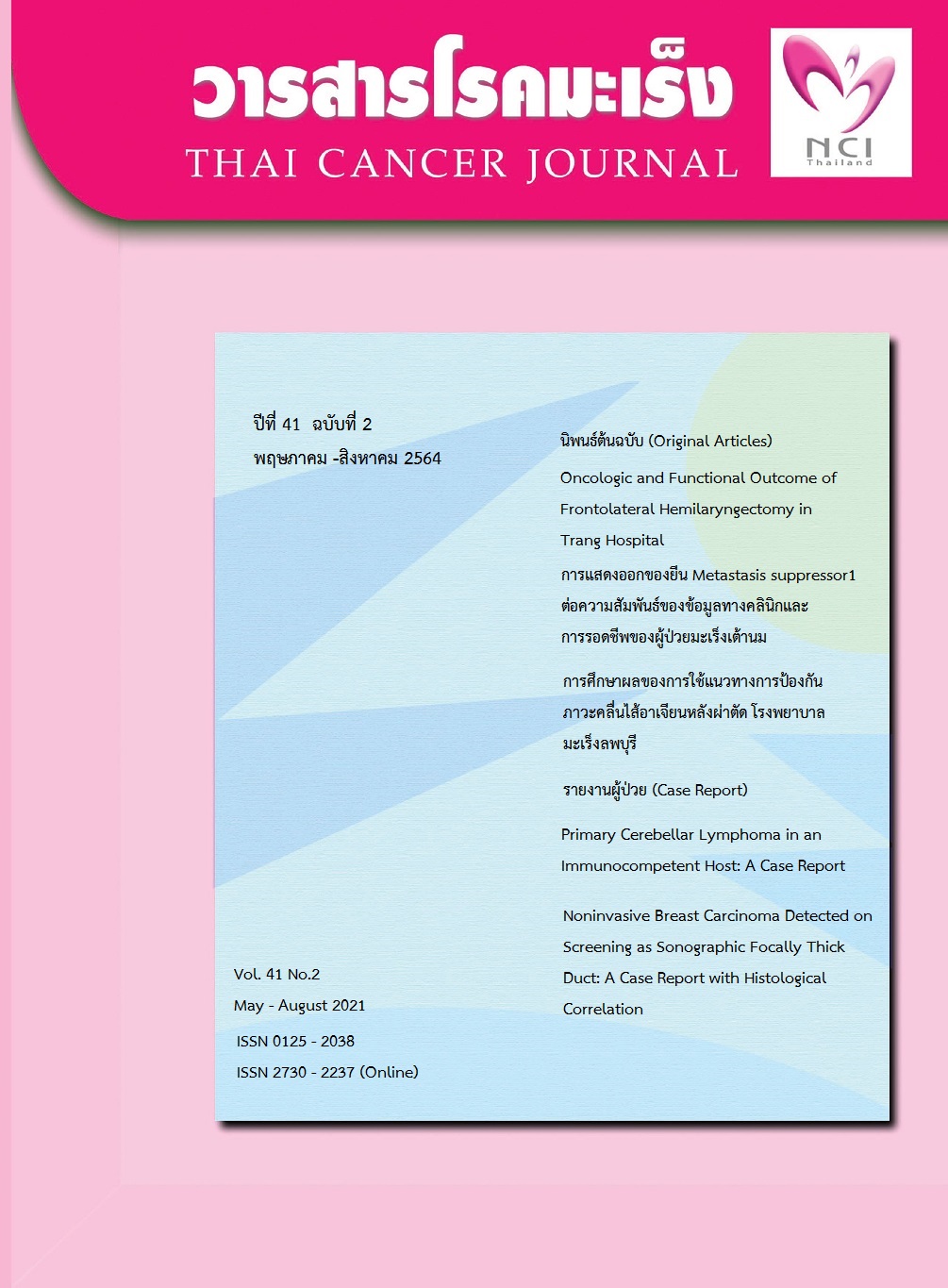Oncologic and Functional Outcome of Frontolateral Hemilaryngectomy in Trang Hospital
Keywords:
Frontolateral hemilaryngectomy, Glottic cancer, Functional outcomeAbstract
Objective:To demonstrate the oncologic and functional outcome of laryngeal cancer patients who underwent front lateral hemilaryngectomy in Trang Hospital. Material and Method: A retrospective study of fourteen patients with squamous cell carcinoma of glottis who underwent front lateral hemilaryngectomy in Trang Hospital between 2010 and 2020. Results: Fourteen patients underwent frontolateral hemilaryngectomy with a mean age of 61.28 years old, and all were male. After surgery, thirteen patients (92.85%) could be decannulated the tracheotomy tube within ten days.Only one could not be decannulated because of post-radiation laryngeal fibrosis. All patients could swallow orally for ten days without aspiration.Thirteen patients had good speaking without a tracheostomy tube after discharge.The five years overall survival rate in our study was 100%. Conclusion Fronto lateral hemilaryngectomy is still a practical option for treating T1b and T2 glottic cancer.The laryngeal functions could mostly be preserved with a reasonable survival rate.
References
Tangjaturonrasme N , Vatanasapt P, Bychkov A.Epidemiology of head and neck cancer in Thailand. Asia Pac J Clin Oncol 2018;14:16-22.doi:10.1111/ajco.12757.
Nocini R, Molteni G,Mattiuzzi C,Lippi G. Updates on larynx cancer epidemiology. Chin J Cancer Res 2020;32:18-25.
Lydiatt WM, Patel SG, O'Sullivan B, Brandwein MS, Ridge JA, Migliacci JC et al. Head and Neck cancers-major changes in the American Joint Committee on cancer eighth edition cancer staging manual. CA cancer J Clin 2017;67:122-37.
Burke LS, Greven KM, McGuirt WT, Case D, Hoen HM, Raben M. Definitive radiotherapy for early glottic carcinoma: prognostic factors and implications for treatment. Int J Radiat Oncol Biol Phys 1997; 38:1001-6.
Dagan R, Morris CG, Bennett JA, Mancuso AA, Amdur RJ, Hinerman RW, et al. Prognostic significance of paraglottic space invasion in T2N0 glottic carcinoma. Am J Clin Oncol 2007;30:186-90.
Nozaki M, Furuta M, Murakami Y, Izawa Y, Iwasaki N, Takahashi H, et al. Radiation therapy for T1 glottic cancer: involvement of the anterior commissure. Anticancer Res 2000; 20:1121-4.
Rothfield RE, Myers EN, Johnson JT. Carci-noma in situ and microinvasive squamous cell carcinoma of the vocal cords. Ann Otol Rhinol Laryngol 1991;100:793-6.
Baird BJ, Sung CK, Beadle BM, Divi V. Treatment of early-stage laryngeal cancer: A comparison of treatment options.Oral Oncol 2018;87:816.doi:10.1016/j.oraloncology.2018.09.012.
Warner L,Lee K, Homer JJ. Transoral laser microsurgery versus radiotherapy for T2 glottic squamous cell carcinoma: a systematic review of local control outcomes.Clin Oto laryngol 2017;42:629-36.
Hartl DM, Landry G, Hans S, Marandas P, Casiraghi O, Janot F, et al.Thyroid cartilage invasion in early-stage squamous cell carcinoma involving the anterior commissure. Head Neck 2012;34:1476-9.
Steiner W, Ambrosch P, Rodel RM, Kron M. Impact of anterior commissure involvement on local control of early glottic carcinoma treated by laser microresection.Laryngoscope 2004;114:1485-91.
Sureepong P, Metheetrairut C.Frontolateral Laryngectomy:Siriraj Experience. J Med Assoc Thai 2014;97:841-9.
Chitapanarux I, Tharavichitkul E, Chakra- bandhu S, Klunklin P, Onchan W, Pukanhapan N, Srikawin J, Sittitrai P, Vongtama R. The treatment outcome of radical radiotherapy in laryngeal cancer. J Med Assoc Thai 2014; 97:101-6.PMID: 24701736.
Bhattacharyya T, Ghoshal S, Dhanireddy B, Kumar R, Sharma SC. Efficacy of radical radiotherapy alone for functional preservation of larynx in laryngeal carcinoma:a retro spective analysis. Indian J Cancer 2014; 51:10-4.doi:10.4103/0019-509X.134600.
Mooney WW, Cole I, Albsoul N, Pearson SA. Salvage vertical partial laryngectomy for radiation failure in early glottic carcinoma. ANZ J Surg 2002;72:746-9.
OGURA JH. Supraglottic subtotal larynxgectomy and radical neck dissection for carcinoma of the epiglottis. Laryngoscope 1958;68:983-1003.
Holsinger FC, Weinstein GS, Laccourreye O. Supracricoid partial laryngectomy: an organ preservation surgery for laryngeal malignancy.Curr Probl Cancer 2005;29:190-200.
Ambrosch P. The role of laser microsurgery in the treatment of laryngeal cancer. Curr Opin Otolaryngol Head Neck Surg 2007;15:82-8.
Davis RK, Hadley K, Smith ME. Endoscopic vertical partial laryngectomy.Laryngoscope 2004;114:236-40.
Myers EN, Alvi A. Management of carcinoma of the supraglottic larynx: evolution, current concepts, and future trends. Laryngoscope 1996;106:559-67.PMID:8628081.
Carney S,Timms S M , Marnane N C, Krishnan S, Rees G, Mirza S. Radiofrequency coblation for the resection of head and neck malig nancies.Otolaryngol Head Neck Surg 2008;138:81-5.
Giovanni A, Guelfucci B, Gras R, Yu P, Zanaret M. Partial frontolateral laryngectomy with epiglottic reconstruction for management of early-stage glottic carcinoma. Laryngoscope 2001;111:663-8.
Downloads
Published
Issue
Section
License
บทความทีตีพิมพ์ในวารสารโรคมะเร็งนี้ถือว่าเป็นลิขสิทธิ์ของมูลนิธิสถาบันมะเร็งแห่งชาติ และผลงานวิชาการหรือวิจัยของคณะผู้เขียน ไม่ใช่ความคิดเห็นของบรรณาธิการหรือผู้จัดทํา







